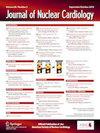Temporal changes in PET myocardial flow reserve: Implications for cardiovascular outcomes
IF 3
4区 医学
Q2 CARDIAC & CARDIOVASCULAR SYSTEMS
引用次数: 0
Abstract
Background
The usefulness of serial measurements of myocardial flow reserve (MFR) has received limited study outside of transplant vasculopathy. We describe the trends of myocardial blood flow and perfusion over time in patients undergoing positron emission tomography (PET) myocardial perfusion imaging (MPI) for the evaluation of coronary artery disease, and their association with cardiovascular outcomes.
Methods
We retrospectively analyzed data from 474 patients without a history of heart transplant who underwent serial PET MPI (N = 948 studies) for the evaluation of coronary artery disease at Yale New Haven Hospital between 2016 and 2022. Patients were categorized according to MFR trajectory (low to low, low to high, high to low, high to high). Long-term major adverse cardiovascular events (MACE), defined as death or myocardial infarction, were analyzed with the Kaplan-Meier method and Cox regression. Log-likelihood, C-statistic and net reclassification were used to assess model performance.
Results
The median interval time between tests was 776 days (IQR: 497-1058). The most common indications for the first and second PET were chest pain and dyspnea. MFR was similar in serial exams (2.1 [1.7, 2.6] vs 2.1 [1.7, 2.5], P = .75), but rest (1 [.8, 1.3] vs .9 [.7, 1] P < .01) and stress flows (2.1 [1.6, 2.8] vs 1.8 [1.4, 2.2], P < .01) were both reduced on the second PET. MFR increased in patients with revascularization between tests (N = 62 patients) (1.6 [1.3, 2.0] vs 1.7 [1.2, 2.2], P = .04). During a median follow-up time of 17 [8,28] months, the rate of MACE was 12% (51 events) and was higher in the low-to-low and low-to-high categories in multivariable analysis. The model including serial MFR and perfusion performed better than the baseline model including traditional clinical risk factors in terms of the likelihood ratio and C-statistic (from .74 to .80, P = .04).
Conclusions
In conclusion, our findings suggest that the serial assessment of MFR and perfusion may improve risk stratification beyond traditional clinical risk factors.

PET 心肌血流储备的时间变化:对心血管预后的影响。
背景:在移植血管病变之外,心肌血流储备(MFR)系列测量的有效性得到了有限的研究。目的:我们描述了接受正电子发射断层扫描(PET)心肌灌注成像(MPI)评估冠状动脉疾病的患者心肌血流和灌注随时间的变化趋势,以及它们与心血管结局的关系。方法:我们回顾性分析2016-2022年间耶鲁大学纽黑文医院474名无心脏移植史的患者(n=948项研究)进行了连续PET MPI评估冠状动脉疾病的数据。根据MFR轨迹(低到低、低到高、高到低、高到高)对患者进行分类。用Kaplan-Meier方法和Cox回归分析定义为死亡或心肌梗死的长期主要不良心血管事件(MACE)。使用对数似然、c统计量和净重分类来评估模型的性能。结果:两次检测的中位间隔时间为776天(IQR: 497-1058)。第一次和第二次PET最常见的适应症是胸痛和呼吸困难。MFR在系列检查中相似(2.1 [1.7,2.6]vs 2.1 [1.7, 2.5], P=0.75),但其余(1 [0.8,1.3]vs 0.9[0.7, 1])。结论:总之,我们的研究结果表明MFR和灌注的系列评估可以改善危险分层,超越传统的临床危险因素。
本文章由计算机程序翻译,如有差异,请以英文原文为准。
求助全文
约1分钟内获得全文
求助全文
来源期刊
CiteScore
5.30
自引率
20.80%
发文量
249
审稿时长
4-8 weeks
期刊介绍:
Journal of Nuclear Cardiology is the only journal in the world devoted to this dynamic and growing subspecialty. Physicians and technologists value the Journal not only for its peer-reviewed articles, but also for its timely discussions about the current and future role of nuclear cardiology. Original articles address all aspects of nuclear cardiology, including interpretation, diagnosis, imaging equipment, and use of radiopharmaceuticals. As the official publication of the American Society of Nuclear Cardiology, the Journal also brings readers the latest information emerging from the Society''s task forces and publishes guidelines and position papers as they are adopted.

 求助内容:
求助内容: 应助结果提醒方式:
应助结果提醒方式:


